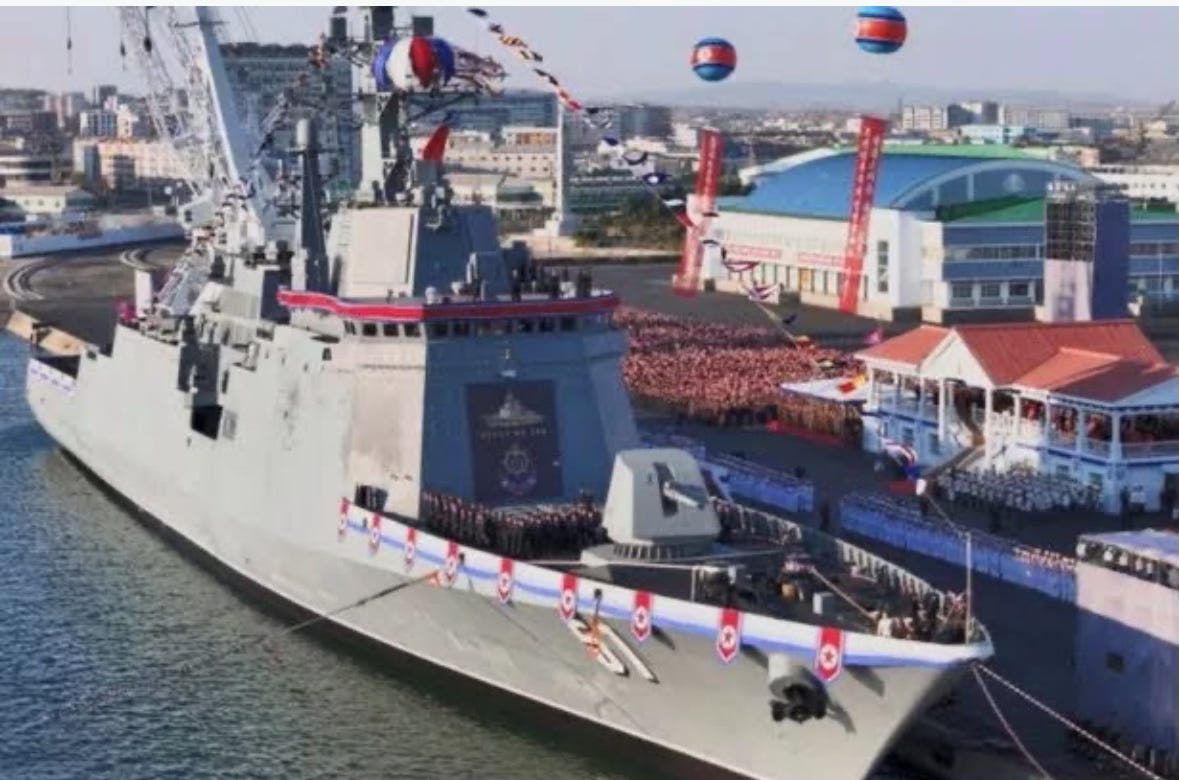The teeth just got cold!
What the hell does that even mean? Well, I'll tell you. Theres a Chinese proverb that states, 'without the lips the teeth get cold'. This proverb is used to described China's relationship with DPRK.
North Korea’s new warship launched on May 21st this year and then, well… it sank. The modern-looking, battle-capable vessel would have been a major achievement for the DPRK. But its inability to stay afloat left it out of action almost immediately. Still, there's more to this story than just a failed launch.
The most shocking part wasn’t just that it sank — but how modern it looked.
Officially named the Choe Hyon-class destroyer, this ship looked strikingly similar to vessels from major naval powers. In particular, it bore a strong resemblance to Russia’s Udaloy-class and Sovremenny-class destroyers. So naturally, the question arises:
What role did Russia play in helping North Korea build its new flagship warship?
Image: The destroyer before launch.
The vessel was supposed to mark a turning point for the North Korean Navy, whose current fleet is mostly composed of aging, rusting ships. A modern, capable destroyer would have signaled a credible threat in an increasingly tense regional climate.
This destroyer was launched sideways — a traditional method often used ceremonially but soon after, it capsized.
Image: The capsized vessel.
The loss was a huge blow for the DPRK. Kim Jong-un blamed "criminal behavior" among those overseeing the project, but in the background, more significant questions emerged:
What does this mean for Russia’s involvement?
Again, the design of the North Korean destroyer looks almost identical to Russian warships. And remember Kim visited Putin in Russia last year. One rumored outcome of that meeting was a deal: North Korea would provide troops and equipment for Russia’s war in Ukraine, and in exchange, Russia would share military technology.
So how similar are the two ships?
Image comparison: North Korean destroyer vs Russian Project 22350 frigate.
Russia’s modern Project 22350 frigates show an uncanny resemblance to the DPRK’s new vessel. Both have a forward-mounted main cannon, vertical missile launch systems, and a square helicopter landing deck at the rear. While many naval ships share these features, the resemblance here goes beyond generic design, even the paint schemes match.
This brings us to a deeper geopolitical question:
Why would Russia help North Korea?
And why might China quietly support this move, even if the launch failed?
Russia benefits immediately: they get troops and ammunition from North Korea in return for providing some military know-how, knowledge much of the world already possesses. But there’s a strategic layer that includes China.
As the old Chinese proverb goes:
“Without the lips, the teeth get cold.”
In this metaphor, North Korea is the lips — and China is the teeth. China needs North Korea as a buffer state, shielding it from direct Western influence and military presence.
But shielding from what?
There is an increasingly strong Western military presence in the region, with U.S. bases in South Korea, Japan, the Philippines, and strong allies like Australia. This puts China in a tight spot — a situation often referred to as the Prolixity Problem. Simply put, China is being boxed in at sea.
Why does this matter?
Because China's ambition to reclaim Taiwan is not just controversial — it’s a flashpoint that could trigger regional war. In such a conflict, the entire region would mobilize, and a strong North Korea would be essential to China and Russia’s strategic depth.
So, what does this all tell us?
If Russia and China are supporting North Korea at this level, even after the embarrassment of the ship sinking, it signals something more serious:
They’re preparing for the possibility of future conflict.
North Korea’s new warship — though it sank — might still represent something far more dangerous than a failed engineering project.
It’s a signal:
Russia and China see strategic value in strengthening the DPRK. Even when things don’t go to plan, the underlying alliance remains intact — and it’s one that the world should be watching very carefully.






